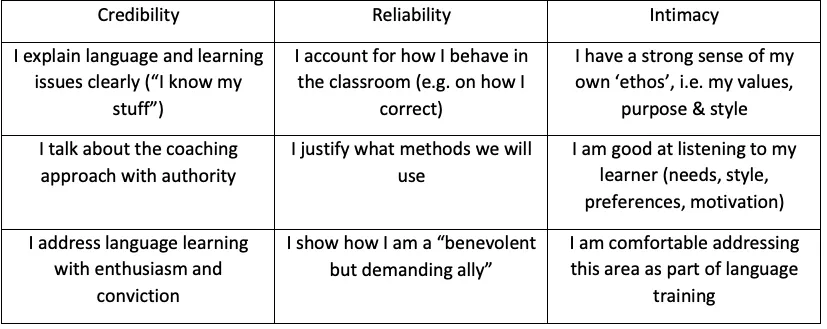Guest post by Ian King
Although the title suggests a simple process, trust-building can be deceptively over-simplified. Actually, it is two or three questions rolled into one here. Let’s unpack them a bit and explain what this article is going to be about.
Firstly, what is trust, or rather, what are its components? I’m going to introduce a simple framework called The Trust Equation which I think is a neat way to dissect the illusive topic of ‘trust’.
Next, how do we apply those principles of trust-building swiftly and online? On this point, we’re going to see how we can adapt the practices of Swift Trust to the setting of online language coaching.
*** The Trust Equation was first explained by David Maister in his book The Trusted Advisor. The equation looks like this:

In the top part of the equation, there are 3 qualities which contribute to being seen as trustworthy. These are credibility, reliability and intimacy. The S under the line is a denominating factor which detracts from trustworthiness: self-orientation. In other words, if someone is too self-oriented, we’re less likely to find them worthy of our trust.
Just to clarify the terms, credibility refers to how believable our words are: whether people think our words make sense, describe reality, etc. Reliability is about our actions: whether we do what we say we will do. Intimacy means whether we feel secure sharing something personal with someone. Lastly, self-orientation has to do with whether people think that we care or not, perceived specifically through the quality of the attention we give people.
Let’s try transposing the trust equation into our world of language coaching. The following table suggests some ways that we can foster credibility, reliability and intimacy in our practice.

Now, what about the added constraint of coaching online? I say constraint because most (but not all) coaches prefer coaching in a physical environment to the online one. Isn’t trust harder to manufacture when we can’t read each other’s body language, when we don’t see how people act socially, when we haven’t “really” met the other person?
Well, maybe not necessarily.
I think there are some simple steps we can take to build trust swiftly. I’m using the word swiftly intentionally because Swift Trust is a recognized term in some fields where trust is a professional requirement. In groups such as film crews, flight crews and surgical teams, crew members don’t always know each other well, or even at all. Trust is based on roles and rules; the default way of working together has been designed before anybody meets or talks and, through training and professional practice, each crew member knows what to do and when to do it. In short, trust is designed.
So how can we design trust into our online coaching?
I think this basically has to do with doing deliberately what we would do automatically or naturally in a physical environment.
Here are some simple tips:
1) Remember that first impressions count. How do you come across on your zoom screen? Is your face brightly lit, level with the camera and with a cool / fun / professional background, or do you look like you’ve been taken hostage by terrorists and you’re secretly filming a request for ransom money on your cell phone in a basement?
2) Follow a simple protocol for introductions. The first time you meet, introduce yourself first (and give them the full speech, they’ll be happy to know your story), then ask the client to do the same. Then, only then, tackle the real business of defining the scope of work.
3) Make people feel secure You could get some inspiration from Maslow’s pyramid of needs. Ask your client if they’re physically comfortable / at ease / preoccupied by anything / ready to work. Have that conversation before diving into work.
4) Explain what you’re doing Take time to detail your intention for the tasks and activities you propose. Get their feedback. Don’t assume that your plan is clear or obvious or doesn’t matter to the client.
5) Discuss rules and roles explicitly What may matter less in a real environment matters more online, where we have limited sensory cues to rely on. Discuss openly what you expect of each other, who does what, how you’re going to interact with each other and how you’re going to correct any mistakes. That way you’ll be building your own swift trust crew.
In conclusion, we can summarise by saying this: let’s deliberately design trust mechanisms into our online language coaching.
By doing this we’ll help the coaching process to move ahead more swiftly, which will enable our clients to make progress and reach their goals faster.






